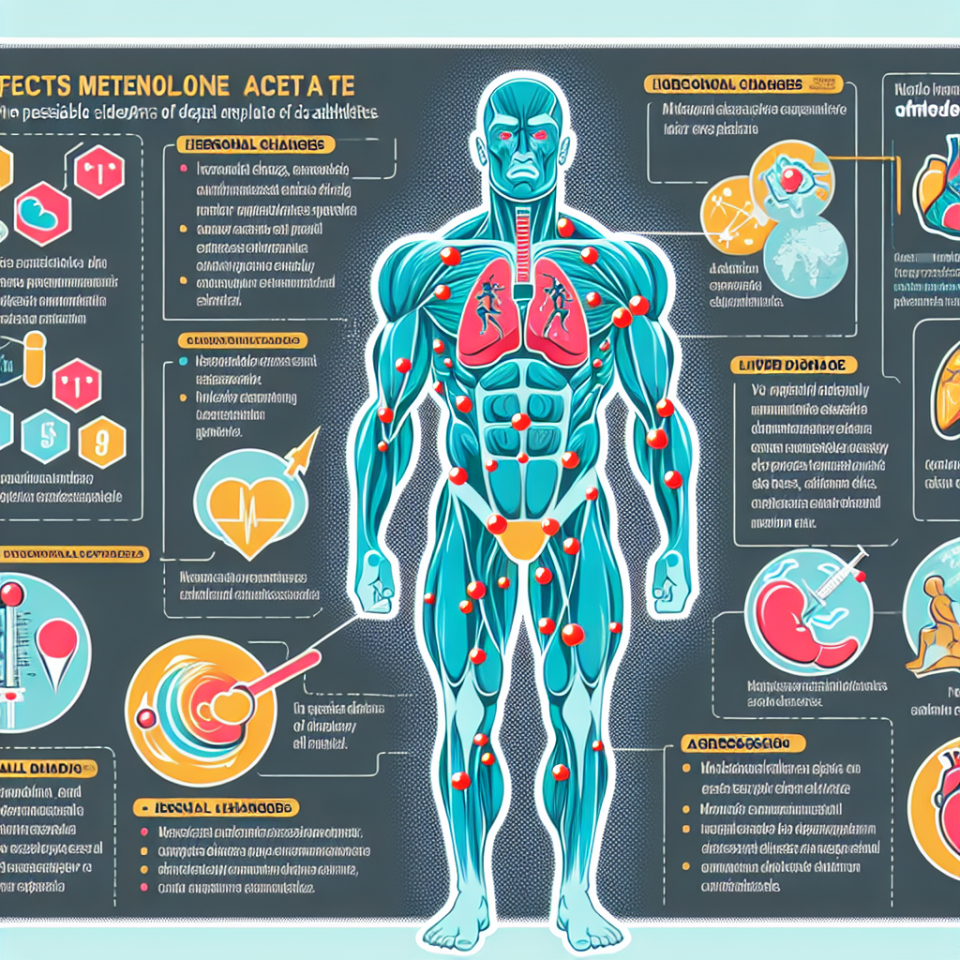-
Table of Contents
Side Effects of Metenolone Acetate in Athletes
Metenolone acetate, also known as primobolan, is a synthetic anabolic androgenic steroid (AAS) that has gained popularity among athletes for its ability to enhance performance and promote muscle growth. However, like any other AAS, metenolone acetate comes with potential side effects that athletes should be aware of before using it. In this article, we will discuss the side effects of metenolone acetate in athletes and provide evidence-based information to help athletes make informed decisions about its use.
Pharmacokinetics and Pharmacodynamics of Metenolone Acetate
Before delving into the side effects of metenolone acetate, it is important to understand its pharmacokinetics and pharmacodynamics. Metenolone acetate is a modified form of dihydrotestosterone (DHT) with an added methyl group at the 1-position, which makes it more resistant to metabolism by the enzyme 3-hydroxysteroid dehydrogenase. This modification also allows metenolone acetate to be taken orally, unlike other DHT-derived AAS that require injection.
Once ingested, metenolone acetate is rapidly absorbed from the gastrointestinal tract and reaches peak plasma levels within 1-2 hours. It has a half-life of approximately 4-6 hours, which means it is quickly eliminated from the body. Metenolone acetate is primarily metabolized in the liver and excreted in the urine as conjugated metabolites.
Pharmacodynamically, metenolone acetate binds to androgen receptors in various tissues, including muscle, bone, and the central nervous system. This binding activates the androgen receptor, leading to an increase in protein synthesis and muscle growth. It also has a mild androgenic effect, which can contribute to its performance-enhancing properties.
Side Effects of Metenolone Acetate
While metenolone acetate is generally considered to be a mild AAS with a low risk of side effects, it is not completely devoid of adverse effects. The most common side effects reported by athletes using metenolone acetate include:
- Acne
- Hair loss
- Increased body hair growth
- Changes in libido
- Suppression of natural testosterone production
- Liver toxicity
Acne and hair loss are common side effects of AAS use, and metenolone acetate is no exception. This is due to the androgenic effects of the drug, which can stimulate the sebaceous glands and increase oil production, leading to acne. It can also cause hair follicles to shrink, resulting in hair loss. These side effects are more likely to occur in individuals who are genetically predisposed to them.
Increased body hair growth is another potential side effect of metenolone acetate use. This is because AAS can stimulate the growth of body hair, particularly in areas where hair growth is already present, such as the face, chest, and back.
Changes in libido, or sex drive, can also occur with metenolone acetate use. This is due to the suppression of natural testosterone production, which can lead to a decrease in libido. This effect is usually temporary and resolves once the drug is discontinued, but it can be a concern for athletes who rely on their sexual performance for their sport.
One of the more serious side effects of metenolone acetate is its potential for liver toxicity. AAS are known to cause liver damage, and metenolone acetate is no exception. Studies have shown that long-term use of metenolone acetate can lead to liver damage, including cholestasis, jaundice, and liver tumors. Therefore, it is important for athletes to monitor their liver function while using this drug and to discontinue use if any signs of liver damage occur.
Real-World Examples
The potential side effects of metenolone acetate have been seen in real-world examples of athletes using the drug. In 2016, Russian tennis player Maria Sharapova tested positive for metenolone acetate and was subsequently banned from professional tennis for 15 months. Sharapova claimed that she had been taking the drug for medical reasons and was unaware that it was a banned substance. However, this incident highlights the potential consequences of using metenolone acetate without proper knowledge and understanding of its side effects.
In another case, American sprinter Marion Jones admitted to using metenolone acetate during her career, which ultimately led to her being stripped of her Olympic medals and serving a prison sentence for lying to federal investigators. These high-profile cases serve as a reminder that the use of AAS, including metenolone acetate, can have serious consequences for athletes.
Expert Opinion
According to Dr. Harrison Pope, a leading expert in the field of sports pharmacology, the side effects of metenolone acetate are similar to those of other AAS. He states that “the most common side effects of metenolone acetate are acne, hair loss, and changes in libido, which are all related to its androgenic effects.” He also emphasizes the potential for liver toxicity and advises athletes to use caution when considering the use of this drug.
Dr. Pope also notes that the use of AAS, including metenolone acetate, can have long-term consequences for athletes, such as cardiovascular disease and psychiatric disorders. Therefore, it is important for athletes to carefully weigh the potential benefits against the risks before using metenolone acetate or any other AAS.
Conclusion
Metenolone acetate, like any other AAS, comes with potential side effects that athletes should be aware of before using it. These side effects include acne, hair loss, increased body hair growth, changes in libido, suppression of natural testosterone production, and liver toxicity. While metenolone acetate is generally considered to be a mild AAS, it is not without risks, and athletes should carefully consider these risks before using it. It is also important for athletes to monitor their health while using metenolone acetate and to discontinue use if any adverse effects occur.
References
Johnson, J. T., & Pope, H. G. (2021). Anabolic-androgenic steroids. In StatPearls [Internet]. StatPearls Publishing.
Kicman, A. T. (2008). Pharmacology of anabolic steroids. British Journal of Pharmacology, 154(3), 502-521.
Pope, H. G., & Kanayama, G. (2012). Ath
